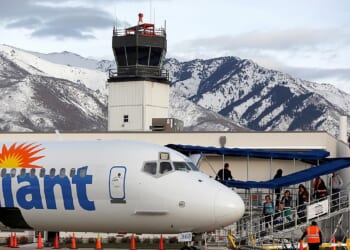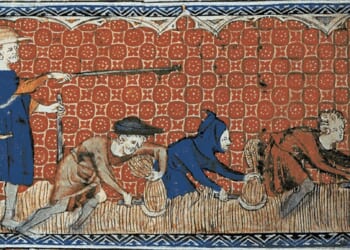A US Navy rear admiral ordered the two Tomcats’ pilots to return to their carrier—but the pilots disobeyed the order to continue to protect soldiers on the ground.
United States Navy Lt. Larry Sidbury and his wingman, Lt. Bryan Roberts, are legends among the naval aviation community for their actions in March 2002. Flying their iconic F-14D Tomcats, the two men refused to return to their aircraft carrier, the USS John C. Stennis (CVN-74)—instead deciding to conduct a dangerous Close Air Support (CAS) mission to aid embattled US Special Forces operators fighting in the Battle of Roberts Ridge during Operation Enduring Freedom (OEF) in Afghanistan.
Having been deployed to provide overwatch for a group of US forces fighting in the Shah-i-Kot Valley of Afghanistan, Sidbury’s F-14 and three others from his carrier had to assist in defending those American troops after an MH-47E helicopter was downed during the battle.
The Battle of Roberts Ridge: A Disaster in the Making
From beginning to end, the mission in Roberts Ridge was a disaster. According to a report written in Aviation Geek Club, the initial mission was supposed to involve a US Special Forces group taking a ridgeline that overlooked the entire valley.
At the time, US forces were unaware that al Qaeda had entrenched hardened forces in those mountains. Once the Special Forces team arrived via an MH-47E, al Qaeda’s fighters opened up on the helicopter and the Special Forces team with everything they had. As a result, the helicopter was forced to break off its operations and leave—without Navy SEAL Petty Ofc. Neil Roberts.
After it was reported that the helicopter, in its haste to leave the area, had inadvertently abandoned a Navy SEAL, Army Rangers were deployed from Bagram Air Base, the main facility where US forces were operating from throughout the War in Afghanistan. But as the MH-47Es were approaching with the Rangers as part of their rescue mission, al Qaeda was waiting—and began firing at the incoming helos. One of the helicopters was shot down, killing four of the soldiers on board. The survivors were made to defend themselves outside the wreckage of the downed bird—with an al Qaeda bunker nearby, with al Qaeda elements pouring out of that bunker, attacking the doomed helicopter and the survivors.
Among the survivors of that horrific crash was United States Air Force Capt. Gabe Brown, who went by the callsign “Slick 01.” Brown was the combat air controller. It was his job to direct all available air assets to attack the hordes of al Qaeda terrorists attacking him and his comrades around the downed bird.
Needing the massive amount of bombs the F-14s carried, Captain Brown requested those Navy birds to fly over the valley and blast apart the hordes of approaching al Qaeda militants. After multiple successful bombing runs, the F-14s had expended their large payload of ordnance. According to after action reports, Sidbury and Roberts worked directly with Brown to bring their heavy ordnance to “within 500 meters” of Brown and his downed comrades in the Valley.
Disobedience Never Looked So Good
With their bombs expended, and running out of fuel, the two F-14s were ordered to break off and return to the USS John C. Stennis. But the two pilots refused.
A US Navy rear admiral and an Air Force general then got on the horn and ordered the pilots to take their bomb-free birds back to the carrier. Sidbury and Roberts again refused—disobeying a direct order from their flag officers. They were not going to return to the carrier because the downed helicopter and the survivors were still under immense enemy fire.
Instead, the pilots chose to bring their mighty M61 Vulcan cannons to bear, carrying out a relentless strafing run against al Qaeda’s forces until they retreated, saving the downed Americans in the valley.
In other words, the F-14 Tomcats made so famous by Tom Cruise in Top Gun, went from dogfighters to A-10 Warthogs. And what a beautiful sight it must have been for the besieged Americans on the ground below!
After the threat to the downed Americans in the valley had abated, the Tomcats returned to the Stennis.
As the story goes, one of their superior officers was waiting for the pilots. He immediately began berating the Tomcat crews for disobeying multiple orders. That is, until an admiral entered the briefing room and overruled the officer berating the F-14 crews.
That admiral, impressed by the heroism and commitment to the fellow servicemembers, commended the F-14 pilots as heroes—and urged them to never act any differently in similar circumstances.
About the Author: Brandon J. Weichert
Brandon J. Weichert is a senior national security editor at The National Interest. Recently, Weichert became the host of The National Security Hour on America Outloud News and iHeartRadio, where he discusses national security policy every Wednesday at 8pm Eastern. He is also a contributor at Popular Mechanics and has consulted regularly with various government institutions and private organizations on geopolitical issues. Weichert’s writings have appeared in multiple publications, including The Washington Times, National Review, The American Spectator, MSN, The Asia Times, and others. His books include Winning Space: How America Remains a Superpower, Biohacked: China’s Race to Control Life, and The Shadow War: Iran’s Quest for Supremacy. His newest book, A Disaster of Our Own Making: How the West Lost Ukraine is available for purchase wherever books are sold. He can be followed via Twitter @WeTheBrandon.
Image: Shutterstock / Dan Simonsen.
















